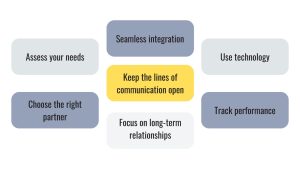Talent Shortage: Strategies for Augmented Teams
Introduction In today’s rapidly changing technology landscape, companies are constantly looking for ways to stay ahead. However, one of the biggest challenges they face is the...

Introduction
In today’s rapidly changing technology landscape, companies are constantly looking for ways to stay ahead. However, one of the biggest challenges they face is the talent shortage. As industries grow and diversify, the demand for skilled professionals far exceeds the supply. This gap makes it increasingly difficult for companies to maintain the necessary workforce to drive innovation and sustain growth. One effective solution to this pressing issue is team augmentation.
Team augmentation, or team expansion, involves integrating augmented experts into the existing workforce to fill skill gaps, manage workload spikes, and speed up project delivery. Not only does this strategy help companies address the talent shortage, but it also brings a host of other benefits. In this article, we’ll explore strategies for effective team augmentation and how it can transform your business operations.
Understanding Talent Shortage
The talent shortage is a global phenomenon that affects industries ranging from IT and healthcare to engineering and manufacturing. There are several factors that contribute to the problem.

- Technological advancement: As technology advances, so does the need for specialised skills. New fields such as artificial intelligence, blockchain, and cybersecurity require knowledge that is still relatively rare.
- Ageing workforce: In many industries, a significant portion of the workforce is approaching retirement age, resulting in a loss of experienced professionals.
- Education gaps: There is often a gap between the skills taught in schools and the demands of the job market. This gap leaves new graduates unprepared for the roles they will be called upon to fill.
- Globalisation: The global nature of business means that companies compete for talent not only locally, but also globally. This increased competition makes it difficult to attract the best talent.
Strategies for Effective Team Augmentation
To make the most of team augmentation, it’s important to approach it strategically. Here are a few key strategies to consider.

- Assess your needs: Before looking for external talent, conduct a thorough assessment of your current workforce and identify specific skill gaps. Understanding your needs will help you find the right experts to complement your team.
- Choose the right partner: Partnering with a reputable team augmentation provider is critical. Look for a partner with a proven track record, industry expertise, and a large talent pool.
- Seamless integration: Successful team augmentation requires seamless integration between your internal and external teams. Ensure that extended team members are effectively onboarded and understand your company’s culture, processes, and goals.
- Keep the lines of communication open: Clear and consistent communication is vital to effective collaboration. Conduct regular check-ins, use collaboration tools, and encourage an open environment where team members can share ideas and feedback.
- Focus on long-term relationships: While team extensions are often used for short-term projects, building long-term relationships with external experts can provide ongoing benefits. Consider retaining high-performing extended team members for future projects.
- Use technology: Use technology to improve collaboration and productivity. Tools like project management software, video conferencing, and cloud platforms can bridge the gap between internal and external team members.
- Track performance: Continuously track the performance of extended team members and the overall success of the extension strategy. Use key performance indicators (KPIs) to measure productivity, quality, and project results.
Real-World Examples
Several companies have successfully implemented team augmentation to overcome talent shortages and achieve their goals. Here are a few examples:
Spotify: To keep up with rapid growth and technological advancements, Spotify used team augmentation to bring in specialised talent for projects ranging from software development to data analytics. This approach allowed Spotify to maintain its competitive advantage in the music streaming industry.
NASA: Faced with the challenge of developing advanced technologies for space exploration, NASA used team augmentation to gain access to expertise in fields such as robotics, artificial intelligence, and materials science. This strategy played a major role in advancing their missions and achieving groundbreaking discoveries.
Uber: To support its global operations and continuous innovation, Uber expanded its teams with external experts in areas such as cybersecurity, machine learning, and mobile app development. This allowed Uber to improve its services and maintain a strong presence in the market.
Conclusion
Overcoming the talent shortage is a complex task that requires innovative solutions. Team augmentation offers a strategic approach to closing skill gaps, managing workload fluctuations, and accelerating project delivery. By understanding your needs, choosing the right partner, and focusing on seamless integration and communication, you can use team augmentation to drive your business forward.
In a competitive and ever-changing environment, team augmentation provides the agility, expertise, and scalability you need to stay ahead. Use this strategy to not only overcome the talent shortage, but also to unlock new opportunities for growth and innovation.